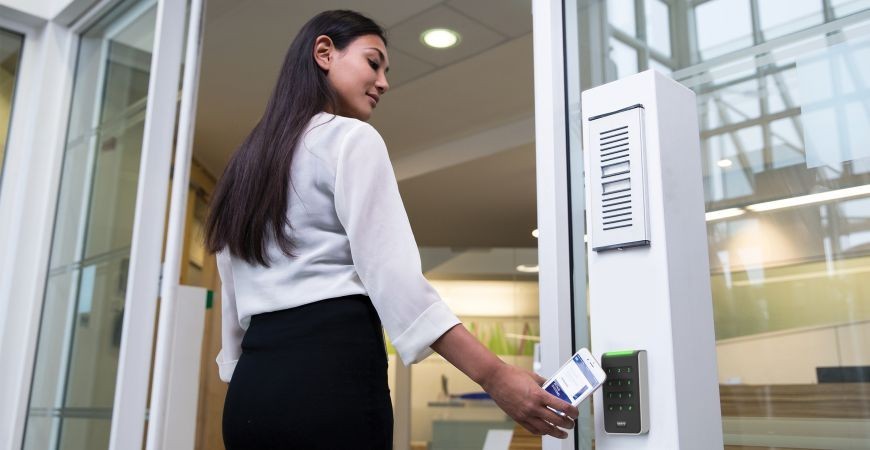
Near Field Communication (NFC) in access control: benefits and challenges
Near Field Communication (NFC) is becoming a part of everyday life and is widely used in smartphone applications such as Google Wallet, Apple Pay, and digital loyalty cards. NFC is also one of the fastest growing trends in the security and access control market. End users are demanding it and more and more card reader manufacturers are introducing NFC functionality into their devices.
Before discussing the benefits and challenges it brings to access control, let's briefly discuss what NFC actually is.
What is short range communication?
Near Field Communication, or NFC, is a short-range wireless technology that allows two electronic devices to communicate wirelessly at a distance of 4 cm or less. Similar to the DESfire or MIFARE type radio frequency identification (RFID), it works at a frequency of 13.56 MHz.
What is the difference between NFC and Bluetooth?
The most important difference between NFC and Bluetooth is the fact that the first technology allows communication in active and passive mode, and the second - only in active mode.
NFC is also faster and easier to use: devices don't require manual pairing like Bluetooth does. Just bring them closer to each other.
The NFC module is characterized by a shorter range (usually several cm), which is why it is also considered more secure than Bluetooth (maximum range of more than 100 m). However, it will mostly work for small files.
Another important difference is power consumption. NFC needs less power than Bluetooth, so it can stay on all the time without draining your battery. However, there is an exception that I have already mentioned: communication in passive mode consumes more power than in active mode.
What is the difference between NFC and RFID?
Both NFC and RFID technology use wireless communication. However, there are some key differences between them.
RFID is a general term for many different frequencies (low frequency, high frequency, and ultra high frequency). In turn, NFC only works at 13.56 MHz, so it uses a narrow RFID branch.
The second is the range - in the case of NFC it is several cm, up to a maximum of 20. In turn, some RFID tags can have a range of up to several tens of meters.
These differences also affect the use of NFC and RFID. The first technology is mainly used to read information via a phone and for contactless payments. On the other hand, RFID is most often used in industry and logistics, e.g. for the tracking and identification of merchandise, in access control systems.
How is short-range communication used in access control?
Card reader manufacturers are increasingly introducing NFC technology into their readers and developing applications that allow access control credentials to be stored on devices such as smartphones. This means that you can use your smartphone or similar device to gain physical access instead of an access control card.
The introduction of the NFC function in the card reader makes it a multifunctional device with the ability to read various kinds of formats. As a result, card readers such as HID Signo are designed with flexibility in mind and interoperate with more than 15 credential technologies, including Seos, HID Mobile Access, MIFARE DESFire EV1/EV2, iCLASS and more, thus , provide much more flexibility.
Benefits of using a phone as an access card
- Make upgrading easy
Using NFC-enabled readers allows for a smoother transition with the retirement of older technologies and the introduction of new ones. For example, you can start using mobile credentials by continuing to use DESfire cards.
- Savings
Since short-range communication allows access control credentials to be stored on mobile phones, an organization may decide that they no longer need physical access control cards. So you can get rid of the costs associated with the purchase and personalization of cards.
- Convenience
People like the simplicity of having access control credentials on a mobile phone so they don't have to remember them or carry around a card or pass.
- Less frequent loss of credentials
Normally the mobile is taken care of more than the access card, so it is more difficult to forget or lose it. This allows not only to increase security, but also to reduce management time and reduce the costs associated with replacing lost cards and providing temporary cards.
Technological limitations
Since various operating systems, such as Android and Apple, receive regular updates, older smartphones may not be able to install the NFC application. On top of that, some phones may just not have room for another app.
If someone changes phones, it could also mean they'll have to download the NFC app and reapply for credentials. In some systems, credentials are assigned to a phone and cannot be reused, which may result in a charge for additional credentials. All this takes time.
You also need to create a plan B in case of a dead battery. NFC-based entrances can, for example, be equipped with an intercom or video verification. Another solution is to provide a nearby charging station.
Choose the technology that best suits you
Each identification technology has advantages and disadvantages, and your choice depends on the expectations and conditions of a specific implementation. When designing an access control system, you can choose one method for external doors and another for internal doors. To improve security standards, two different methods can also be combined, the first identifying the user and the second verifying the user. For example, in the case of a room with valuable items, you may need an access card to identify yourself and then a PIN or fingerprint authentication for verification.
Do you want more information about access control and future-oriented protection? We will be happy to help you, contact us.

